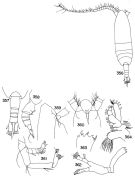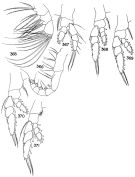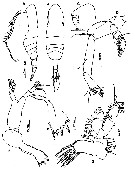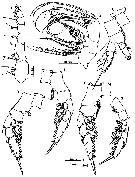|
|
 |
Fiche d'espèce de Copépode |
|
|
Calanoida ( Ordre ) |
|
|
|
Arietelloidea ( Superfamille ) |
|
|
|
Augaptilidae ( Famille ) |
|
|
|
Haloptilus ( Genre ) |
|
|
| |
Haloptilus caribbeanensis Park, 1970 (F) | |
| | | | | | | Syn.: | Haloptilus furcatus : Grice, 1969 a (p.454, figs.F) | | | | Ref.: | | | Park, 1970 (p.478, 537, Descr.F, figs.F); Matthews, 1972 (p.49); Soh & al., 1999 a (p.130, Redescr.F, figs.F, Rem.) |  Issued from : T. S. Park in Bull. Mar. Sc., 1970, 20 (2). [p.538, Figs.356-364]. Female (from Caribbean Sea): 356, habitus (dorsal); 357, urosome (dorsal); 358, idem (lateral right side); 359, forehead (lateral); 360, idem (ventral); 361, A2; 362, Md; 363, Md (cutting edge); 364, Mx1. Nota: Head and 1st thoracic segment separate, 4th and 5th fused. Prosome about 3 times length of urosome. Forehead in dorsal view broadly rounded without a distinct projection. Rostrum consisting of 2 slender filaments. A1 reaching about end of caudal ramus. Md: cutting edge with 7 teeth of different shape and size. Mx1 with 5 setae on basis; 4+5 setae on endopod; 11 setae on exopod. Genital segment slightly shorter than the following three combined. Caudal ramus about 2.5 times as long as wide. Exopod of A2 8-segmented, first seven segments each with 1 seta and last with 4 setae. Mx1 with 5 setae on basis; 4 + 5 on endopod; exopod with 11 setae.
|
 Issued from : T. S. Park in Bull. Mar. Sc., 1970, 20 (2). [p.539, Figs.365-371]; Female: 365, Mx2; 366, Mxp; 367, P1 (anterior); 368, P2 (anterior); 369, P3 (anterior); 370, P4 (anterior); 371, P5 (anterior). Nota: P1 with endopod 2-segmented and exopod 3-segmented; 1st external spine of exopod much longer than the following three spines of equal length.
|
 issued from : G.D. Grice in Bull. mar. Sc., 1969, 19 (2). [p.452, Figs.58-67]. As Haloptilus furcatus. Female (from G. of mexico): 58, habitus (dorsal); 59, forehead (lateral); 60, idem (ventral); 61, urosome (lateral left side); 62, Md (cutting edge of mandibular blade); 63, Mx1; 64, P1; 65, P3; 66, P4; 67, P5.
|
 issued from : H.Y. Soh, H.-L. Suh & S. Ohtsuka in J. Fish. Sci. Tech., 1999, 2 (2). [p.130, Fig.1]. Female (from Suruga Bay): A-B, habitus (dorsal and lateral, respectively); C, forehead (lateral); D, A2; E, Md; F, Md (mandibular cutting edge); G, Mx1. Nota: Rostrum well developed, with 2 long filaments. A1 reaching about end of caudal rami; ancestral segments I to III and XXVII to XXVIII completely fused. A2 with coxa bearing 1 inner seta; basis with 2 setae of unequal length; endopod about 1.9 times as long as exopod, 1st endopodal segment with 2 setae of unequal length nearly twice as long as 2nd segment carrying 9 setae on inner lobe and 7 setae on outer lobe; exopod 8-segmented and segmental fusion: I-1, II-1, III-1, IV-1, V-1, VI-1, VII-1, VIII-X-4. Md with coxal gnathobase bearing 5 subequal teeth and strongly chitinized dorsalmost seta; 1st and 2nd central teeth elongate; mandibular palp lacking basal seta, with both rami nearly equal in length; endopod 2-segmented, 1st endopodal segment with 2 setae, 2nd segment with 10 setae; exopod 5-segmented with setation formula 1, 1, 1, 1, 2. Mx1with 9 spiniform setae on praecoxal arthrite; coxa with 2 setae on endite and 9 setae on epipodite; basis bearing 4 and 5 setae on 1st and 2nd endites, respectively; endopod with 2 free segments, 1st segment with 4 setae, 2nd segment with 1 subterminal seta and 4 terminal setae; exopod very elongate, with 11 setae.
|
 ssued from : H.Y. Soh, H.-L. Suh & S. Ohtsuka in J. Fish. Sci. Tech., 1999, 2 (2). [p.131, Fig.2]. Female: A, Mx2, B, Mxp; C, P1; D, P2; E, P3; F, P4; G, P5. Arrowheads indicate positions of gland openings. Nota: Mx2 with praecoxa and coxa incompletely separate, proximal endite of praecoxa with 3 setae and 1 vestigial elements, distal endite with 3 setae; coxa with endites each bearing 3 setae; basis with 2 setae; endopod 4-segmented with setal formula 3, 2, 2. Mxp syncoxa with 1st to 4th endites bearing 0, 2, 3, 3, 3 setae, respectively; basis with 2 medial setae, armed with minute spinules or setules along inner margin; endopod -5-segmented plus 1st endopodal segment completely incorporatd into basis; setation formula of endopod 2, 4, 4, 3, 3, 4.
| | | | | NZ: | 2 | | |
|
Carte de distribution de Haloptilus caribbeanensis par zones géographiques
|
| | | | Loc: | | | Caribbean Sea, Gulf of Mexico, Japan (Suruga Bay) | | | | N: | 4 | | | | Lg.: | | | (88) F: 6,42; (225) F: 5,83; (1117) F: 6,15; {F: 5,83-6,42} | | | | Rem.: | bathypélagique.
Voir aussi les remarques en anglais | | | Dernière mise à jour : 06/01/2015 | |
|
|
 Toute utilisation de ce site pour une publication sera mentionnée avec la référence suivante : Toute utilisation de ce site pour une publication sera mentionnée avec la référence suivante :
Razouls C., Desreumaux N., Kouwenberg J. et de Bovée F., 2005-2025. - Biodiversité des Copépodes planctoniques marins (morphologie, répartition géographique et données biologiques). Sorbonne Université, CNRS. Disponible sur http://copepodes.obs-banyuls.fr [Accédé le 24 décembre 2025] © copyright 2005-2025 Sorbonne Université, CNRS
|
|
 |
 |








